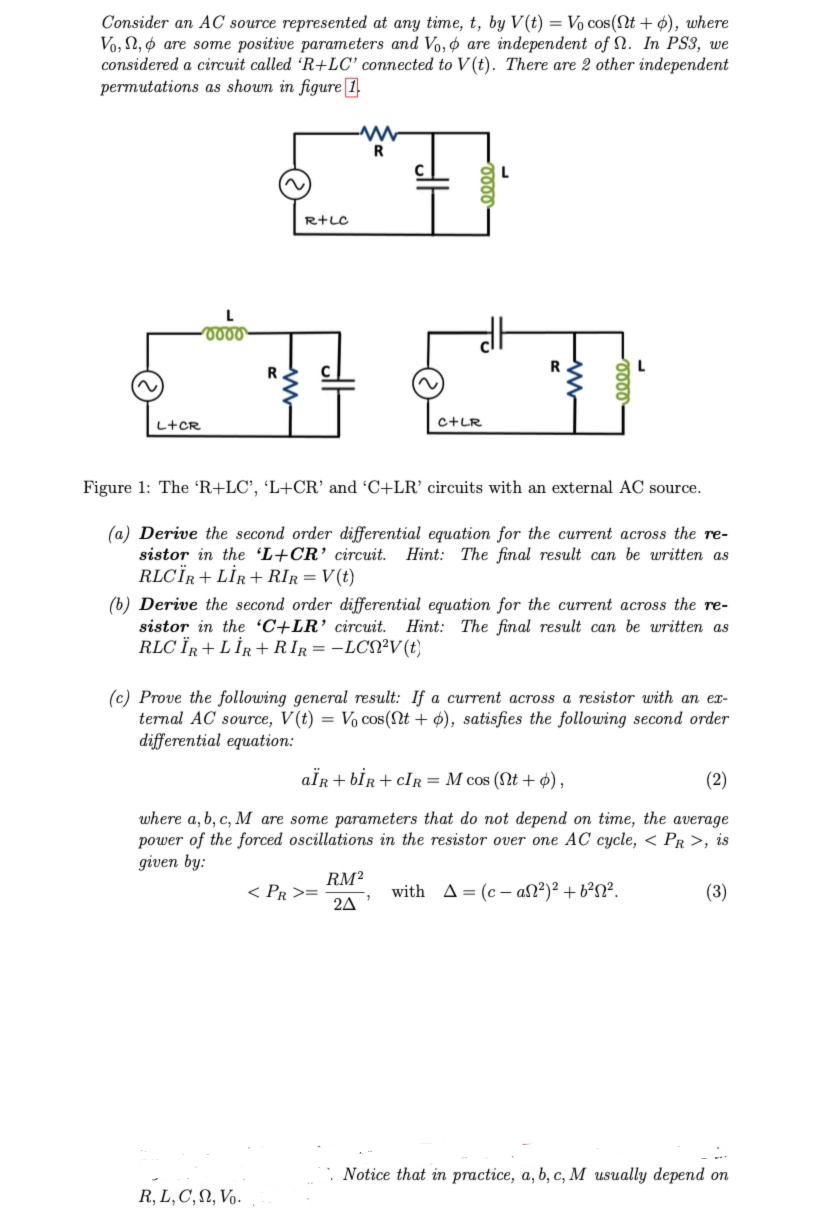(a) Derive the second order differential equation for the current across the re- sistor in the 'L+CR' circuit. Hint: The final result can be written as RLCÏR+LIR + RIR = V(t) (b) Derive the second order differential equation for the current across the re- sistor in the 'C+LR' circuit. Hint: The final result can be written as RLC ÏR+LIR + RIR=-LCN²V (t) (c) Prove the following general result: If a current across a resistor with an ex- ternal AC source, V(t) = Vo cos(t + o), satisfies the following second order differential equation: aÏR + bİR+CIR = M cos (nt + o), (2) where a, b, c, M are some parameters that do not depend on time, the average
(a) Derive the second order differential equation for the current across the re- sistor in the 'L+CR' circuit. Hint: The final result can be written as RLCÏR+LIR + RIR = V(t) (b) Derive the second order differential equation for the current across the re- sistor in the 'C+LR' circuit. Hint: The final result can be written as RLC ÏR+LIR + RIR=-LCN²V (t) (c) Prove the following general result: If a current across a resistor with an ex- ternal AC source, V(t) = Vo cos(t + o), satisfies the following second order differential equation: aÏR + bİR+CIR = M cos (nt + o), (2) where a, b, c, M are some parameters that do not depend on time, the average
Introductory Circuit Analysis (13th Edition)
13th Edition
ISBN:9780133923605
Author:Robert L. Boylestad
Publisher:Robert L. Boylestad
Chapter1: Introduction
Section: Chapter Questions
Problem 1P: Visit your local library (at school or home) and describe the extent to which it provides literature...
Related questions
Question
this is not a graded question! its just an assignment based on completion; but i want to know how to do it; please help me with part c

Transcribed Image Text:Consider an AC source represented at any time, t, by V(t) = Vo cos(t + o), where
Vo, , are some positive parameters and Vo, o are independent of . In PS3, we
considered a circuit called 'R+LC' connected to V(t). There are 2 other independent
permutations as shown in figure 1
L+CR
0000
R+LC
-WW
R
R, L, C, N, Vo.
d
C+LR
Figure 1: The 'R+LC', 'L+CR' and 'C+LR' circuits with an external AC source.
(a) Derive the second order differential equation for the current across the re-
sistor in the 'L+CR' circuit. Hint: The final result can be written as
RLCÏR+LIR + RIR = V(t)
< PR >=
L
(b) Derive the second order differential equation for the current across the re-
sistor in the 'C+LR' circuit. Hint: The final result can be written as
RLCÏR + LIR+RIR = -LCN²V(t)
R
(c) Prove the following general result: If a current across a resistor with an ex-
ternal AC source, V(t) = Vo cos(t + o), satisfies the following second order
differential equation:
RM²
24
aÏR + bİR+CIR = M cos (nt + o),
(2)
where a, b, c, M are some parameters that do not depend on time, the average
power of the forced oscillations in the resistor over one AC cycle, < PR >, is
given by:
with A=(c-an²)² + b²N².
(3)
Notice that in practice, a, b, c, M usually depend on
Expert Solution
This question has been solved!
Explore an expertly crafted, step-by-step solution for a thorough understanding of key concepts.
This is a popular solution!
Step 1: Summary of the question
VIEWStep 2: Analyzing the circuit by converting it to s-domain.
VIEWStep 3: Calculating the time domain expression for current through the resistor.
VIEWStep 4: Derivation for C+LR circuit
VIEWStep 5: expression of dynamic equation
VIEWStep 6: Calculation for average power
VIEWSolution
VIEWTrending now
This is a popular solution!
Step by step
Solved in 7 steps with 21 images

Knowledge Booster
Learn more about
Need a deep-dive on the concept behind this application? Look no further. Learn more about this topic, electrical-engineering and related others by exploring similar questions and additional content below.Recommended textbooks for you

Introductory Circuit Analysis (13th Edition)
Electrical Engineering
ISBN:
9780133923605
Author:
Robert L. Boylestad
Publisher:
PEARSON

Delmar's Standard Textbook Of Electricity
Electrical Engineering
ISBN:
9781337900348
Author:
Stephen L. Herman
Publisher:
Cengage Learning

Programmable Logic Controllers
Electrical Engineering
ISBN:
9780073373843
Author:
Frank D. Petruzella
Publisher:
McGraw-Hill Education

Introductory Circuit Analysis (13th Edition)
Electrical Engineering
ISBN:
9780133923605
Author:
Robert L. Boylestad
Publisher:
PEARSON

Delmar's Standard Textbook Of Electricity
Electrical Engineering
ISBN:
9781337900348
Author:
Stephen L. Herman
Publisher:
Cengage Learning

Programmable Logic Controllers
Electrical Engineering
ISBN:
9780073373843
Author:
Frank D. Petruzella
Publisher:
McGraw-Hill Education

Fundamentals of Electric Circuits
Electrical Engineering
ISBN:
9780078028229
Author:
Charles K Alexander, Matthew Sadiku
Publisher:
McGraw-Hill Education

Electric Circuits. (11th Edition)
Electrical Engineering
ISBN:
9780134746968
Author:
James W. Nilsson, Susan Riedel
Publisher:
PEARSON

Engineering Electromagnetics
Electrical Engineering
ISBN:
9780078028151
Author:
Hayt, William H. (william Hart), Jr, BUCK, John A.
Publisher:
Mcgraw-hill Education,